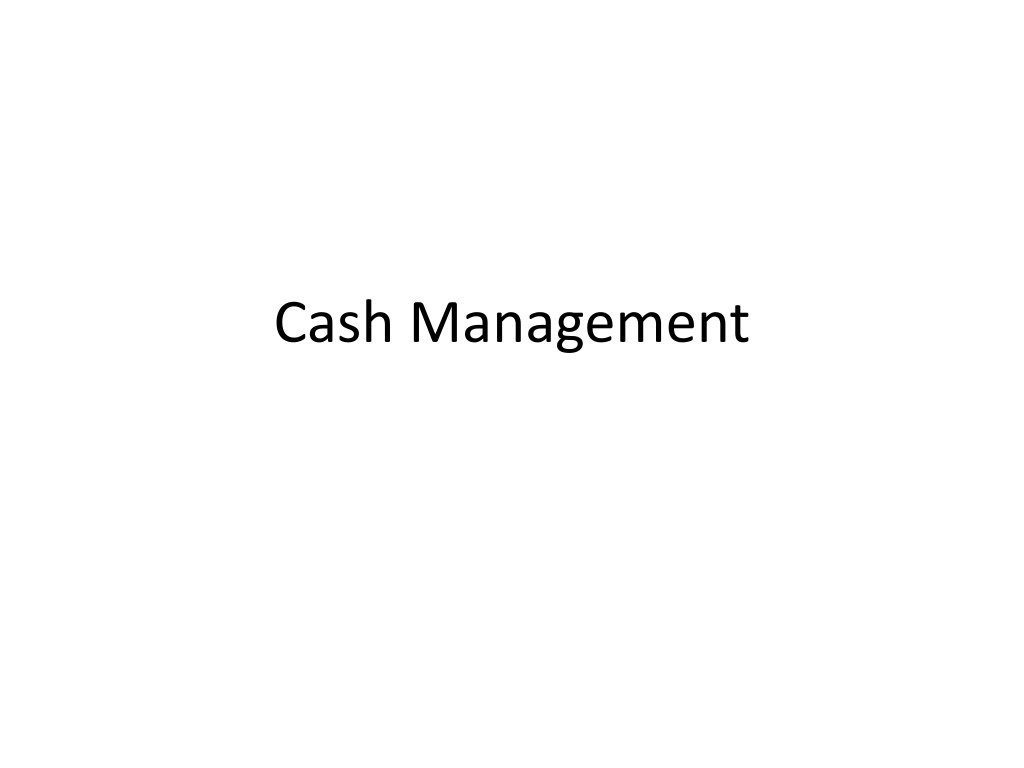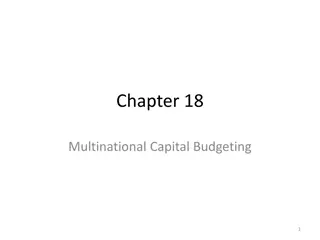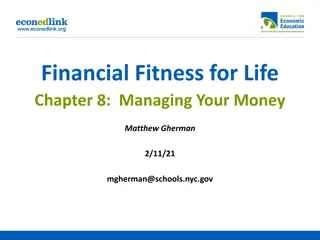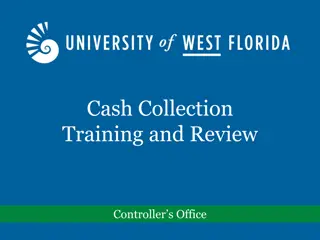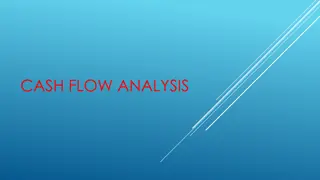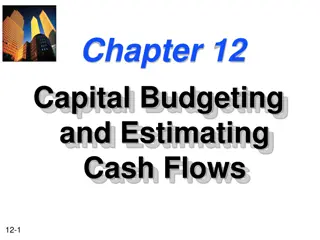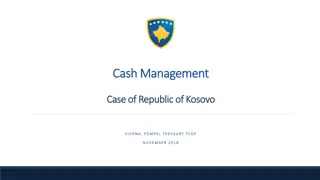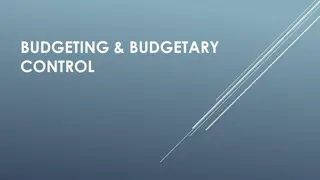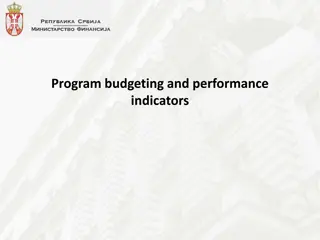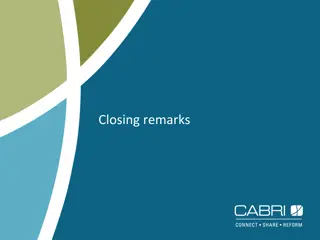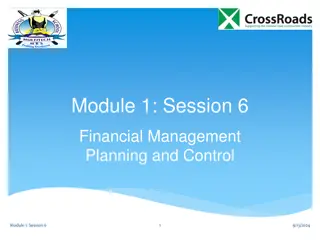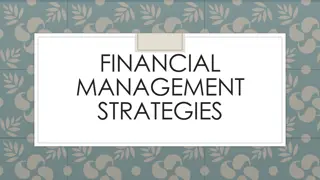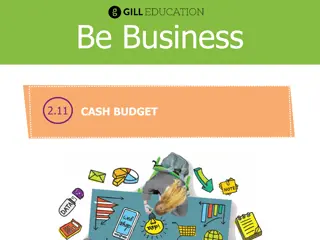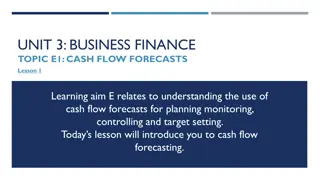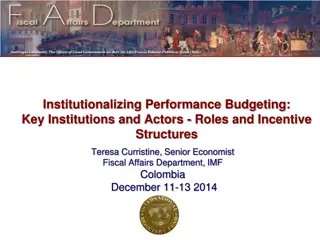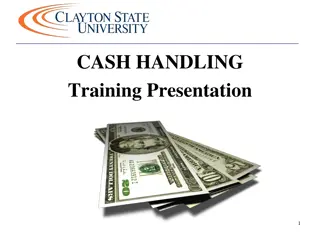Cash Management and Budgeting Analysis
Detailed analysis of cash management and budgeting for a company, including cash flow projections, budget preparation, loan management, and sales forecasts. Explore motives, models, transactions, and precautionary aspects to optimize financial planning."
Download Presentation

Please find below an Image/Link to download the presentation.
The content on the website is provided AS IS for your information and personal use only. It may not be sold, licensed, or shared on other websites without obtaining consent from the author.If you encounter any issues during the download, it is possible that the publisher has removed the file from their server.
You are allowed to download the files provided on this website for personal or commercial use, subject to the condition that they are used lawfully. All files are the property of their respective owners.
The content on the website is provided AS IS for your information and personal use only. It may not be sold, licensed, or shared on other websites without obtaining consent from the author.
E N D
Presentation Transcript
Cash management Motives : (i)Transaction motive: (ii)Precautionary motive: (iii)Speculative motive: (iv)Compensation motive: Commercial banks; compensating balance Liquidity Vs Profitability Float management Models : Baumol model & Miller Orr
(A cash budget is a financial plan) ) A Ltd. has given the following information for the four quarter of the year 2012-13, as anticipated as on 31st March 2012.(Rs. in '000) Q1 Q2 Q3 Q4 Sales 7,500 10,500 18,000 10,500 Production cost 7,000 10,000 8,000 8,500 Selling & distribution costs 1,000 2,000 2,900 1,600 Purchase of Assets 100 1,100 2,100 2,100
Opening Cash (Rs) Opening Debtors (Rs) Debtors at the end of each quarter are one-third of the sales of that quarter. The company wants that a cash balance of Rs. 5,00,000 must be kept at all times to meet the precautionary and speculative requirements. Borrowings can be made in the multiples of Rs.10,000 at the beginning of any quarter and borrowings once made can only be returned at quarter end. Required: Prepare a cash budget for the year 2012-13 and state the amount of loan outstanding as on 31/03/13. : : 6,50,000 30,00,000
Cash-budget for year 2012-13 Q1 Q2 Q3 Q4 Opening balance 6,50,000 5,50,000 5,00,000 5,00,000 Receipts: Cash sales 50,00,000 70,00,000 1,20,00,000 70,00,000 Collection from debtors 30,00,000 25,00,000 35,00,000 60,00,000 loan 35,50,000 Payments: Production cost 70,00,000 1,00,00,000 80,00,000 85,00,000 S &D COST 10,00,000 20,00,000 29,00,000 16,00,000 Purchase of assets 1,00,000 11,00,000 21,00,000 21,00,000 Payment of 25,00,000 8,00,000
The following sales forecasts for the first five months of the next financial year of Max and Associates are available: MONTHS Rs April 40,000 May 45,000 June 55,000 July 60,000 August 50,000
Other data are as follows: (i) debtors and creditors balances at the beginning of the year are Rs 30,000 and 14,000 respectively. The balances of other relevant assets and liabilities are: Cash balance 7,500 Stock 51,000 Accrued sales commission 3,500 (ii)40% sales are on cash basis. Credit sales are collected in the month following sale. (iii) cost of sales is 60% of sales (iv) the only other variable cost is a 5% commission to sales agent. The sales commission is paid in the month after it is accrued. (v) inventory/stock is kept equal to two months budgeted sales. (vi)trade creditors are paid in the following month after purchases (vii) fixed costs are 5,000 per month, including 2,000 depreciation. Prepare a cash budget for the first three months of next financial year.
April May June Opening balance 7,500 33,000 37,000 Receipts: Cash sales 16,000 18,000 22,000 Collection from debtors 30,000 24,000 27,000 Total 46,000 42,000 49,000 Payments: Fixed costs 3000 3000 3000 Sales commission 3,500 2000 2250 Payment to creditors 14,000 33,000 36,000 Total payments 20,500 38,000 41,250
Inventory Management Baumol model ABC Analysis A firm purchases 2000 units of a particular item per year at a unit cost of Rs. 20. the ordering cost is Rs 50 per order and inventory carrying cost is 25%. (i)Determine the optimal order quantity and minimum total cost including purchase cost. (ii)if a 3% discount is offered by the supplier for purchases in a lot of 1000 or more, should the firm accept the offer?
Solution EOQ = 2??/? A = Annual usage of inventory O = Ordering cost per order C = Carrying cost per unit EOQ = 2??/? EOQ = 2 2000 50 = 200 units 5
comparison No. of orders 10 2 Ordering cost(p.a) 500 100 Avg. inventory 100 500 Inventory cost(p.u) 5 4.85 Carrying cost(p.a.) 500 2425 Purchase price(p.u) 20 19.4 Purchase cost(p.a.) 40,000 38,800 Total cost(2000) 41000 41325 EOQ Offer (200 units) (1000units)
Solution Purchase price = 60/ per kg Ordering cost = 360 + 390 = 750 per order Carrying cost = .50 *12 + 9 = 15 per kg EOQ = 2??/?, A = 1,00,000/2.5 =40,000 EOQ = 2 40,000 750 No. of order to be placed = 40,000/2000 = 20 orders Frequency of order = 360/10 = 36 days = 2000 kg 15
Comparison No. of orders 20 4 Ordering cost 750/ 750/ Ordering cost(p.a) 15,000 3000 Avg. inventory 1000kg 5000 Inventory cost(p.u) 15/ 15/ Carrying cost(p.a.) 15,000 75,000 Purchase price(p.u) 60/ 58.8 Purchase cost(p.a.) 24,00,000 23,52,00 Total cost(2000) 24,30,000 24,30,000 EOQ Offer (2000 Kg) (10,000Kg)
